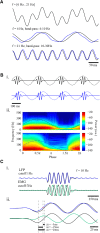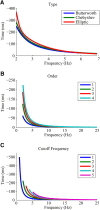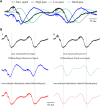Filter-Based Phase Shifts Distort Neuronal Timing Information
- PMID: 29766044
- PMCID: PMC5952323
- DOI: 10.1523/ENEURO.0261-17.2018
Filter-Based Phase Shifts Distort Neuronal Timing Information
Abstract
Filters are widely used for the modulation, typically attenuation, of amplitudes of different frequencies within neurophysiological signals. Filters, however, also induce changes in the phases of different frequencies whose amplitude is unmodulated. These phase shifts cause time lags in the filtered signals, leading to a disruption of the timing information between different frequencies within the same signal and between different signals. The emerging time lags can be either constant in the case of linear phase (LP) filters or vary as a function of the frequency in the more common case of non-LP (NLP) filters. Since filters are used ubiquitously online in the early stages of data acquisition, the vast majority of neurophysiological signals thus suffer from distortion of the timing information even prior to their sampling. This distortion is often exacerbated by further multiple offline filtering stages of the sampled signal. The distortion of timing information may cause misinterpretation of the results and lead to erroneous conclusions. Here we present a variety of typical examples of filter-induced phase distortions and discuss the evaluation and restoration of the timing information underlying the original signal.
Keywords: filters; neurophysiology; oscillations; phase; timing; waveform.
Figures






Similar articles
-
Filter based phase distortions in extracellular spikes.PLoS One. 2017 Mar 30;12(3):e0174790. doi: 10.1371/journal.pone.0174790. eCollection 2017. PLoS One. 2017. PMID: 28358895 Free PMC article.
-
Optimal digital filters for analyzing the mid-latency auditory P50 event-related potential in patients with Alzheimer's disease.J Neurosci Methods. 2016 Jun 15;266:50-67. doi: 10.1016/j.jneumeth.2016.03.013. Epub 2016 Mar 22. J Neurosci Methods. 2016. PMID: 27015794
-
Principles of digital sampling of a physiologic signal.Electroencephalogr Clin Neurophysiol. 1993 Oct;89(5):349-58. doi: 10.1016/0168-5597(93)90075-z. Electroencephalogr Clin Neurophysiol. 1993. PMID: 7691575 Review.
-
Filter transient response to EEG waveforms.Int J Biomed Comput. 1987 Jan;20(1-2):87-95. doi: 10.1016/0020-7101(87)90017-1. Int J Biomed Comput. 1987. PMID: 3557698
-
Nonlinear multivariate analysis of neurophysiological signals.Prog Neurobiol. 2005 Sep-Oct;77(1-2):1-37. doi: 10.1016/j.pneurobio.2005.10.003. Epub 2005 Nov 14. Prog Neurobiol. 2005. PMID: 16289760 Review.
Cited by
-
Standardized measurement error: A universal metric of data quality for averaged event-related potentials.Psychophysiology. 2021 Jun;58(6):e13793. doi: 10.1111/psyp.13793. Epub 2021 Mar 29. Psychophysiology. 2021. PMID: 33782996 Free PMC article.
-
Different Methods to Estimate the Phase of Neural Rhythms Agree But Only During Times of Low Uncertainty.eNeuro. 2023 Nov 3;10(11):ENEURO.0507-22.2023. doi: 10.1523/ENEURO.0507-22.2023. Print 2023 Nov. eNeuro. 2023. PMID: 37833061 Free PMC article.
-
The modulation of brain network integration and arousal during exploration.Neuroimage. 2021 Oct 15;240:118369. doi: 10.1016/j.neuroimage.2021.118369. Epub 2021 Jul 6. Neuroimage. 2021. PMID: 34242784 Free PMC article.
-
A Miniature Dual-Biomarker-Based Sensing and Conditioning Device for Closed-Loop DBS.IEEE J Transl Eng Health Med. 2019 Aug 30;7:2000308. doi: 10.1109/JTEHM.2019.2937776. eCollection 2019. IEEE J Transl Eng Health Med. 2019. PMID: 31667027 Free PMC article.
-
Good scientific practice in EEG and MEG research: Progress and perspectives.Neuroimage. 2022 Aug 15;257:119056. doi: 10.1016/j.neuroimage.2022.119056. Epub 2022 Mar 10. Neuroimage. 2022. PMID: 35283287 Free PMC article.
References
Publication types
MeSH terms
LinkOut - more resources
Full Text Sources
Other Literature Sources
